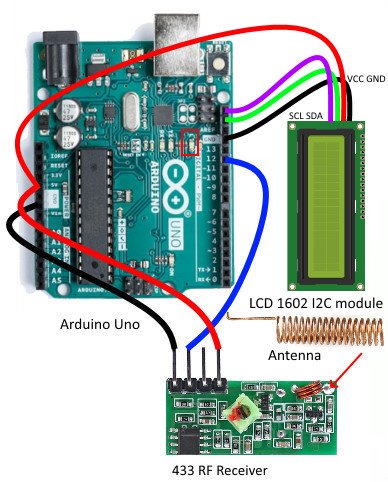433MHz RF receiver module is the most common and cheapest RF receivers for commercial use. This module helps to receiver the 433MHz frequency commonly but it also has a node on it which is changeable by users for different frequencies. The variable node can adjust the frequency from 315MHz to 433MHz. The module can receive the data but it is unable to decode and view the data from the receiver without using any third device. Most of the time smart boards and microcontrollers interface with the receiver. The output of the module comes in an encoded form that is decodable through programming and encoders. On the other hand, it works well with the 433MHz RF transmitter module.
433MHz RF receiver Pinout diagram
433MHz RF receiver has 6 pins, which offers 4 types of functions. The pinout diagram depicts the functionality of all these pins.
Pin Configurations Description
VCC Pin: VCC is the power input pin for the RF module. The power will active the internal circuit to make it functional.
GND Pin: For common ground, the RF module has only one ground pin. The module needs to use with other devices and the common ground will help the RF module to interface with external devices.
Data Pin: 433MHz RF Module has two data input pins which are internally common with each other. Only data should receive from one pin at a time.
Antenna Pin: This module has an antenna pin which helps to connect the external wire to extend the range up to 100 meters. The size of the antenna will depend on the operating frequency.
433MHz RF Receiver Module Features
- The RF receiver delivers the output in an encoded form.
- The operating voltage range of the module is 5V maximum.
- The frequency of the receiver is changeable using a green node present on it.
- It is one of the cheapest receivers and has low power consumption.
- 433MHz RF module uses the ASK/OOK signal as an input.
433MHz RF Receiver Applications
- The RF receiver has a vast use in the home automation.
- In-home security, most of the burglar alarm uses the RF receiver to receive the data.
- RF module receives the data from remote in the car.
- Remote keyless entries also use the RF module for receiving the data.
How to use RF receiver
The RF receiver module may look simple to use but it is a little bit hard to receive the data from itself. The module receives the data in the form of a signal and sends it to the data pin. The data received by the module is always in an encoded form which is decodable by two methods. The first one is through programming and the second is a decoder.
Programming with Arduino or STM32
433MHz RF receiver module receives data in the form of ASK modulated form. To demodulate it an internal program can help. For microcontroller boards, some libraries are usable to demodulate/decode the signal. Some of them are:
- #include <REGx051.H> (C-language)
- #include <RH_ASK.h> (Arduino and STM32F103C8)
These two libraries may look easy but, it is hard to receive the data and convert it in its original form. Sometimes the converted data may look corrupt. To avoid data corruption another method is available. This circuit diagram shows the interfacing of this module with Arduino.
You can read this complete tutorial for a complete step by step guide:
Decoder
The decoder is specially designed to convert the data of the 433MHz RF receiver module from encoded form to 4-bits. This converted data is received able by any external device or IC. This conversion of data removes the programming limit to the controllers. Almost any programming language is useable with a decoder to decode the data.
Antenna Requirement for RF Receiver Module
The external antenna can be attached to the RF receiver module to extend its range. To extend the range the module should have 23cm wire for 315MHz and 17cm for 433.92MHz. These both are the minimum and maximum range of antenna at the maximum and minimum level of frequencies. Others are extractable by taking them as a reference.
Security Issue
The RF receiver module always receives the data from the RF transmitter which broadcasts the data in the form signal. Every signal of the RF transmitter which has the same frequency is received by the RF module. The secure connection can be established by using programming and encoder/decoders.
Other Wireless Modules:




Is it possible to pair with (gate) remote controller which use SMC5326 or another chip such as AX5326, PT2262, PT2264 and SC2262?